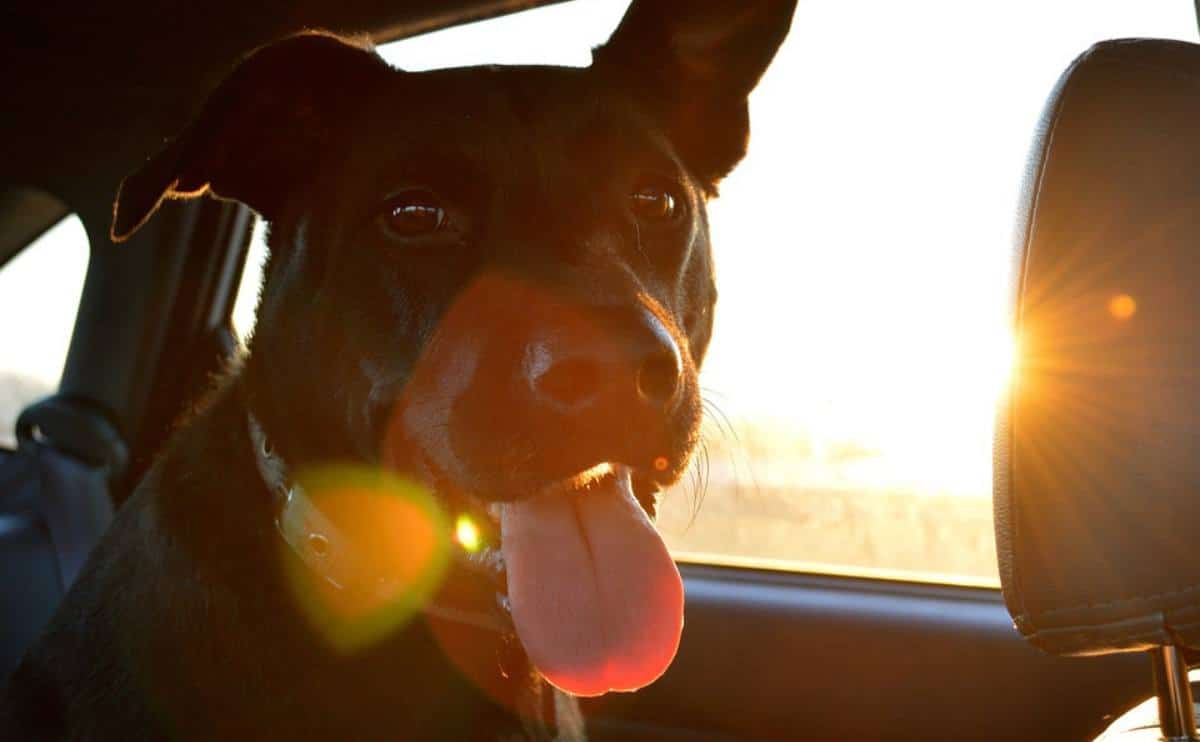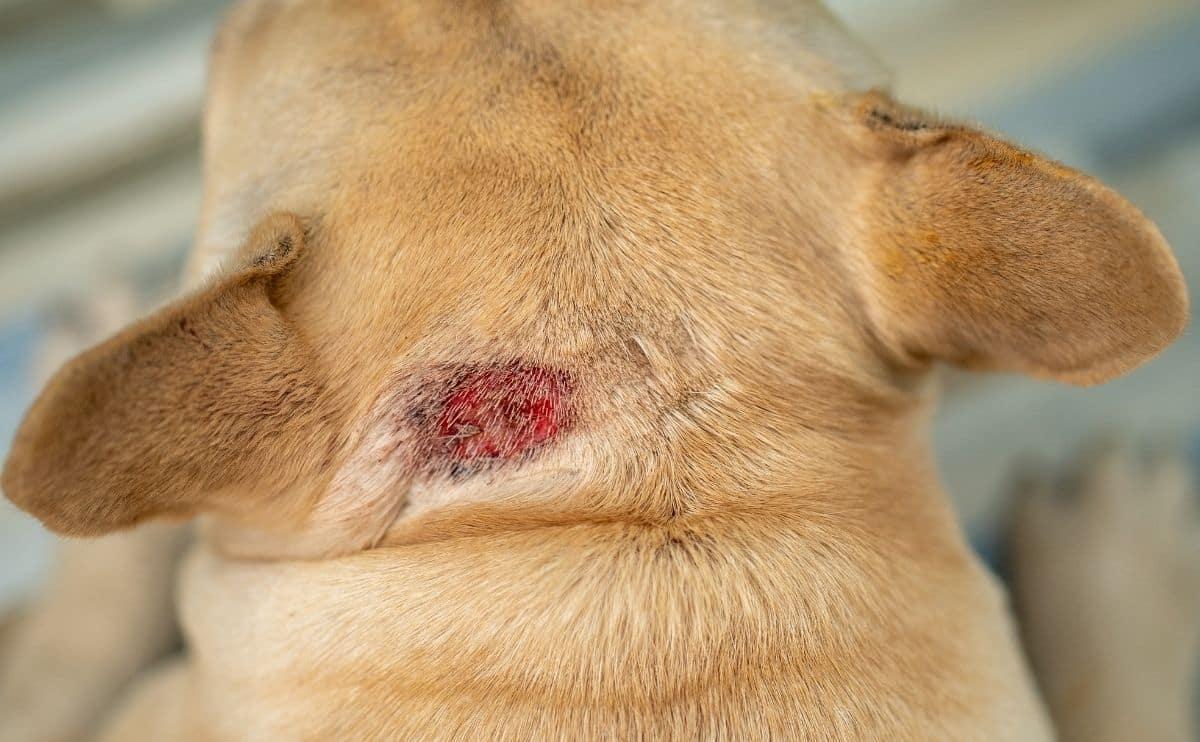Red Eyes in Dogs: When It’s Normal — and When It’s an Emergency
When you purchase through links on our site, we may earn a commission. Here’s how it works.
Notice your dog’s eyes looking red, bloodshot, or a little “off”? You’re right to be concerned. Dog red eyes aren’t just unsettling. They can also be a sign of a serious health issue. They can be a significant warning sign of anything from mild allergies to severe conditions, such as glaucoma, infections, or injury. As experienced dog owners and canine researchers, we know how confusing it feels when your pup’s eyes suddenly look irritated, swollen, or watery.
Table of Contents
In this guide, I’ll break down the causes, symptoms, and treatment options for bloodshot eyes in dogs and help you understand when it’s safe to monitor at home and when it’s time to see a veterinarian. I’ll also share trusted advice to help you keep your dog’s eyes healthy for the long term. Let’s dive in and ensure you have all the necessary information to protect your dog’s vision and overall health.
Why Are My Dog’s Eyes Red Or Bloodshot?
It’s always a little alarming to look at your dog and see red, irritated eyes staring back at you. While the first thought might be panic, not every case of dog red eyes is an emergency. Still, red or bloodshot eyes are never something you should ignore.
Redness happens when the blood vessels in your dog’s eye or eyelids become enlarged or inflamed. This could be triggered by something as simple as dust blowing into the eye. Here are a few of the most common reasons your dog’s eyes might turn red:
- Mild irritation from wind, dirt, or smoke
- Seasonal or environmental allergies
- Bacterial or viral infections (like conjunctivitis)
- Scratches, cuts, or trauma to the eye
- Dry eye (keratoconjunctivitis sicca)
- Glaucoma, causing increased pressure inside the eye
- Cherry eye or prolapsed third eyelid
- Uveitis (inflammation inside the eye)
Alternatively, it could be a sign of a more serious underlying issue, such as an infection or injury. Other underlying health conditions, like diabetes, hyperthyroidism, and some cancers, can also cause red eyes. Therefore, it is essential to consult with your veterinarian to receive a proper diagnosis, particularly if your dog exhibits chronic red eyes.
Knowing the cause is critical because some eye conditions can permanently affect your dog’s vision if left untreated. The key is to watch for additional symptoms, such as swelling, discharge, cloudiness, or pain, and to get veterinary advice when in doubt.
In the next section, I’ll walk through these causes in more detail and explain which signs should prompt you to book a vet appointment right away.
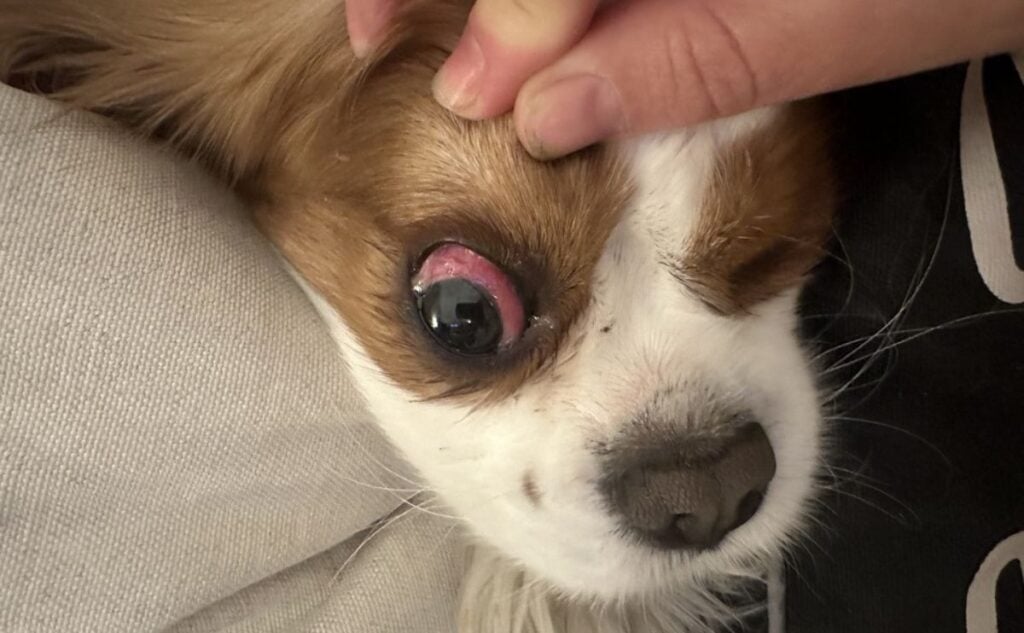
Top 9 Causes Of Red Eyes In Dogs
There’s no one-size-fits-all reason behind dog red eyes, and that’s exactly why it’s important to know the most common causes. Some issues are mild and clear up on their own, but others can get worse fast without treatment.
These are some of the common causes of red eyes in dogs, but your vet may have a different or more specific diagnosis.
1. Irritation
Sometimes, the simplest answer is the right one. Your dog’s red eye could simply be an irritation to a foreign object, like dirt, dust, or grass, that has gotten into his eye. Other minor irritants, such as smoke, cleaning sprays, and perfumes, can also cause temporary redness in your dog’s eyes.
Symptoms
- Eye redness
- Tears or watery discharge
- Itchy eyes (pawing at his eyes or rubbing his face)
Treatment
A mild irritation will usually clear up on its own, so check your dog’s eyes after a couple of hours to see if the redness is gone. If you’re concerned, please call your veterinarian’s office. They may suggest rinsing your dog’s eye out with lukewarm water to flush out the irritant. If redness persists for more than a day, it is best to schedule an appointment with your veterinarian.
2. Allergies
Many dogs develop allergies to environmental factors, such as mold, dust mites, and grasses, throughout their lifetimes. Some dogs also get seasonal allergies, just like humans. If you’ve noticed that your dog has chronic bloodshot eyes and other symptoms listed below, they may have an allergy.
Symptoms
- Eye redness
- Tears or watery discharge
- Itchiness in eyes and/or skin
- Excessive scratching and licking of the skin
- Red or inflamed skin
- Hair loss
- Sneezing
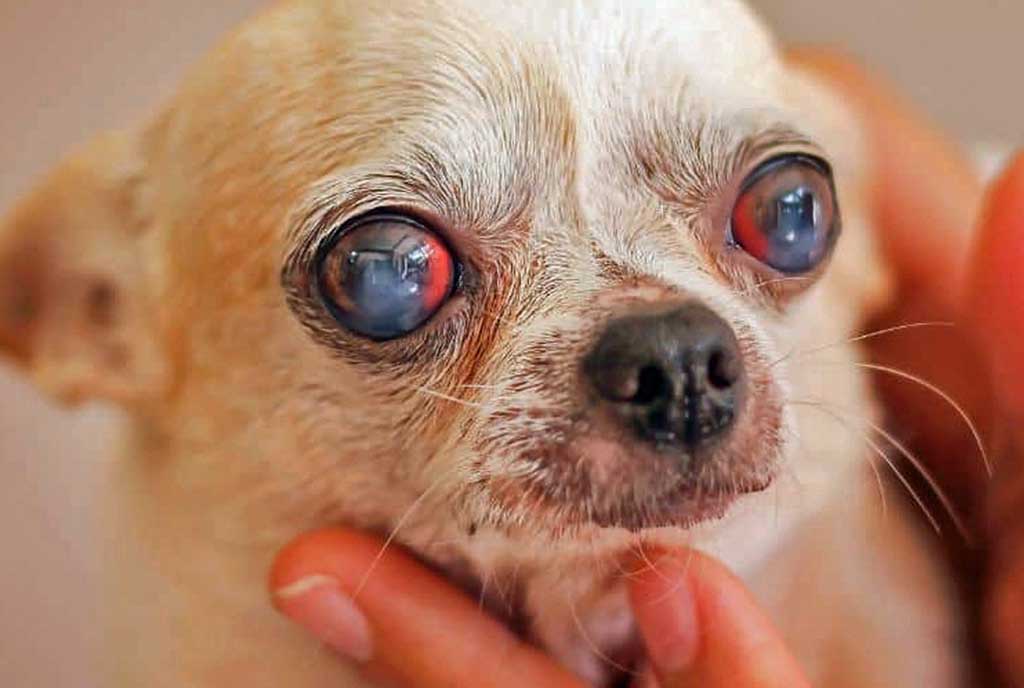
Treatment
Dog allergies are best handled by your veterinarian, who can help you determine what’s causing his allergies and treat the specific cause appropriately. Don’t try to give your dog over-the-counter allergy medicine without first consulting with your vet.
Dog Allergy Testing
If you suspect allergies may be the culprit of your dog’s red eyes, these at-home dog allergy tests may give you some answers. These kits test for a wide variety of environmental factors and food ingredients that your dog may not tolerate well. Once you receive the results, consult with your veterinarian about any treatment options.
3. Injury
Dogs play hard, and this can lead to eye injuries. A ball could accidentally hit your dog’s eye, or he could poke his eye with a stick.
Symptoms
- Whites of the eyes are red
- Swelling and reddening of the eyelid and area around the eye
- Tears or watery discharge right after the incident
- Squinting
Treatment
If you think your dog’s eye was injured, consult with your vet to make sure your dog’s cornea wasn’t scratched. Minor eye injuries typically clear up within 24 hours. If redness and swelling persist, be sure to contact your veterinarian.
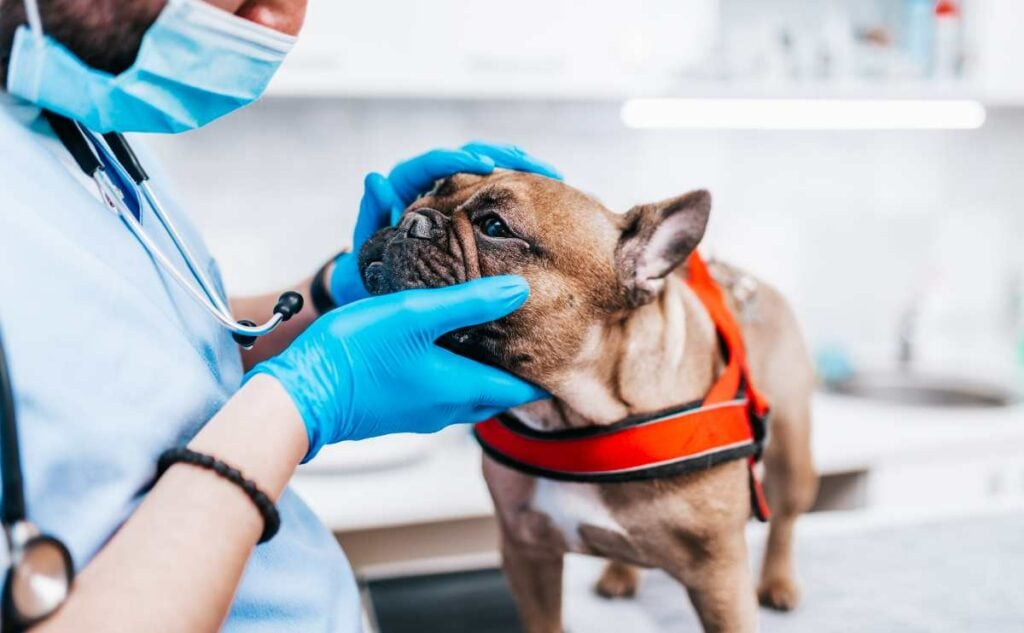
4. Pink Eye
Is your dog’s eye red and swollen? Dogs can get pink eye (conjunctivitis) just like humans do. Infectious conjunctivitis is caused by a virus or bacteria and is quite common in dogs. Dogs can also get non-infectious pink eye, which can be caused by irritation, allergies, injury, dry eye, parasites, or tumors.
Symptoms
- Red or puffy eyes
- Clear, watery eye discharge
- Goopy eye discharge with mucous that could be yellowish or greenish
- Red, swollen eyelids
- Squinting or excessive blinking
Treatment
Pink eye should be diagnosed and treated by your veterinarian. They can determine whether it’s infectious, which would require prescription eye drops to reduce inflammation, fight infection, and, if necessary, stimulate tear production. If the cause is viral or bacterial, your vet may also need to prescribe another medication to treat the underlying condition.
5. Dry Eye
Keratoconjunctivitis sicca, commonly called dry eye, is a condition in which the tear glands don’t produce enough tears, causing the cornea to dry out and become inflamed. The most common causes include immune-mediated diseases that damage the tear glands (an inherited disorder that’s not well understood), systemic diseases such as canine distemper, hypothyroidism, and sulfa medications.
Some breeds are more likely to develop dry eye, including:
- American Cocker Spaniel
- Bloodhound
- Boston Terrier
- Cavalier King Charles Spaniel
- English Bulldog
- English Springer Spaniel
- Lhasa Apso
- Miniature Schnauzer
- Pekingese
- Pug
- Shih Tzu
- West Highland White Terrier
- Yorkshire Terrier
Symptoms
- Painful, red eyes
- Thick, yellowish, mucoid discharge
- Squinting, excessive blinking, or holding the eyes shut
Treatment
Your vet will test your dog’s eyes to determine the level of moisture the tear glands are producing. Veterinarians usually prescribe special moisturizing eye drops for you to administer to your dog once or twice a day. They also recommend gently cleaning the eyes several times a day with a warm, wet washcloth to help relieve pain and stimulate tear film production.
Your veterinarian may also check for corneal ulcers, which commonly occur in conjunction with dry eye. In many dogs, dry eye is a chronic, lifelong condition.

6. Glaucoma
Is your dog’s eye cloudy and red? He could have glaucoma, a condition caused by too little aqueous (eye) fluid draining from the eye — the fluid buildup creates swelling, pressure, and pain. Over time, this pressure causes damage to the eyeball structure and leads to vision loss and even blindness if left untreated.
There are two types of glaucoma: primary (inherited) glaucoma and secondary glaucoma, which is caused by another condition such as injury, infection, cancer, uveitis, or retinal detachment.
Some popular breeds that are more prone to inherited glaucoma include:
- Basset Hound
- Beagle
- Chow Chow
- Cocker Spaniel (American and English)
- Norwegian Elkhound
- Poodle
- Siberian Husky
Symptoms
- Bloodshot whites of the eyes
- Cloudy eyes (sometimes with a bluish tint)
- Swollen or bulging eyes
- Watery discharge
- Dilated pupils
- Poor vision
- Pain
Treatment
If your vet suspects glaucoma, you may be referred to a veterinary ophthalmologist. They use a tool called a tonometer to measure the pressure within the eye, known as intraocular pressure.
In less severe cases, vets prescribe medications that decrease fluid production and promote drainage to treat the increased pressure. In severe or advanced cases where optic nerve damage is already present, dogs may require surgery to improve fluid drainage.
7. Cataracts
Another condition that makes dogs’ eyes cloudy and red is cataracts. When a cataract develops in an eye, it forms a film in the front of the eye. The film prevents light from passing normally through the lens to the back of the eye, causing blurry vision and if left untreated over time, pain.
Dogs (and humans) can develop cataracts in one or both eyes, but the condition is more frequent in both eyes. There are several causes of cataracts in dogs, including age, trauma, metabolic diseases such as diabetes, and genetics.
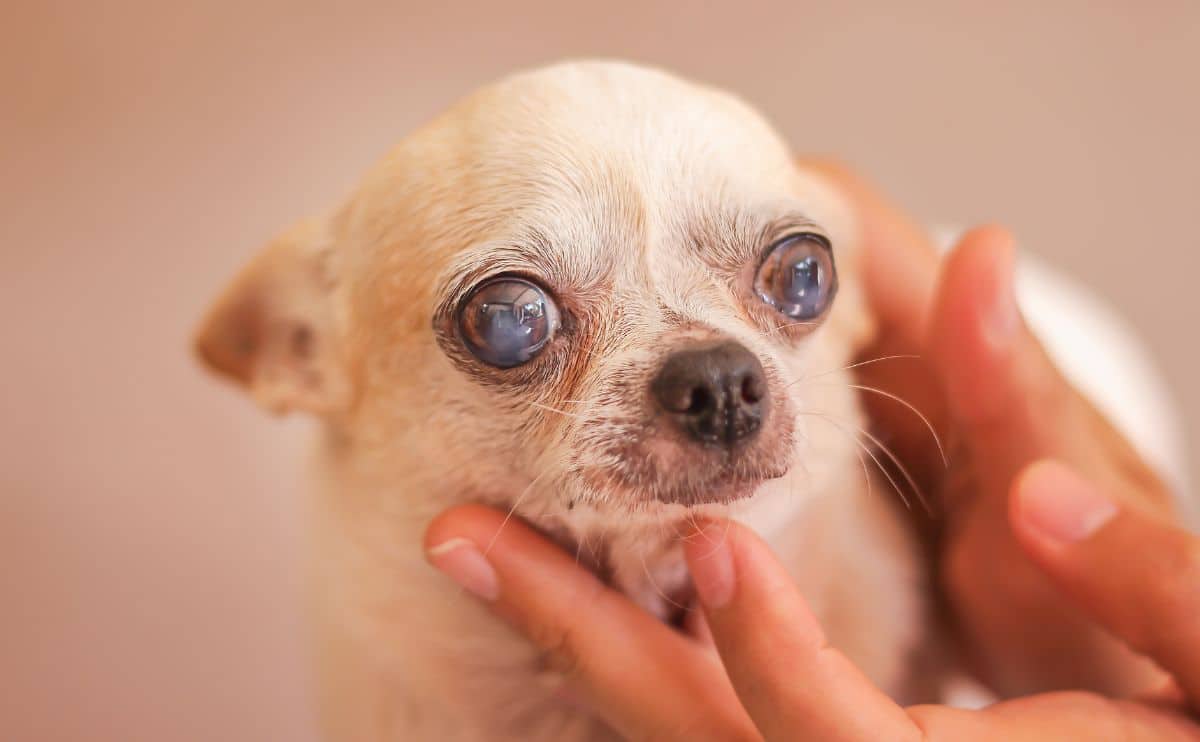
Some popular breeds that are more susceptible include:
- American Cocker Spaniel
- Boston Terrier
- Golden Retriever
- Miniature Poodle
- Miniature Schnauzer
- Siberian Husky
Symptoms
- Cloudy white or gray film over the center of the eye lens
- Chronic eye redness
- Eye socket inflammation
- Bulging of one eye compared to the other
- Noticeable vision problems, especially in dimly lit conditions
- Squinting
- Pawing at eyes
Treatment
If your vet suspects cataracts, you may be referred to a veterinary ophthalmologist. There are limited medications, including topical eye ointments and eye drops, which can postpone the need for surgery, but cataracts will not go away without surgery. Cataracts in dogs can progress rapidly, so it’s important to get your dog treated.
8. Uveitis
Uveitis is an inflammation of one or more of the structures of the uvea. The uvea is the tissue at the front of the eye made up of the iris, choroid, and ciliary body. Uveitis is a serious, painful condition that can lead to permanent vision loss.
Common causes are viral infections (rabies, distemper), bacterial infections (Lyme disease, leptospirosis), parasitic infections (toxoplasmosis, ehrlichiosis), fungal infections (blastomycosis, histoplasmosis, cryptococcosis, coccidioidomycosis), metabolic disease (such as diabetes), high blood pressure, autoimmune diseases, toxins that get into the eye, trauma, and tumors.
Symptoms
- Eye redness
- Discharge
- Squinting
- Avoiding bright light
- Cloudy or dull eyes
Treatment
Veterinary treatment for uveitis depends on the underlying cause and may include prescription eye drops, oral medications, eye ointments, and pain relievers. Your veterinarian will likely run diagnostic tests to narrow down the cause and treat the underlying condition.
9. Cherry Eye
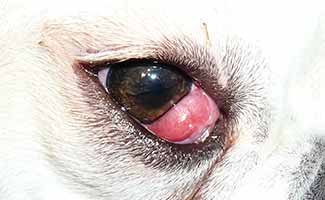
All dogs have a third eyelid that normally stays hidden in the inner corner of the eye. However, some dogs have a genetic disorder that weakens the fibrous attachment holding the third eyelid gland in place. This causes the eyelid to bulge in the inner corner of the eye. Cherry eye (technically called prolapse of the third eyelid gland) is rarely seen in dogs over two years old.
Popular breeds that are most commonly affected include:
- Basset Hound
- Beagle
- Bloodhound
- Boston Terrier
- Bulldog
- Cocker Spaniel
- Lhasa Apso
- Shih Tzu
Symptoms
- Pink or red bulge in the inner corner of the eye
- Inability to close the eye
- Pawing or rubbing at the eye
Treatment
Treatment of cherry eye involves surgically replacing the third eyelid gland. Sometimes, the best surgical option is to remove the third eyelid gland, but dry eye could develop as a result. Your vet will discuss the best surgical technique for your pup.
It’s essential to treat cherry eye as soon as possible to minimize permanent damage to the eye or the third eyelid gland. The third eyelid gland produces up to 50% of the watery (aqueous) portion of the eye’s tear film. Without this tear production, your dog is likely to develop dry eye, which can impair vision.
How Pet Insurance Can Help You And Your Dog
Eye problems in dogs, and especially in some breeds, are very common. Vet bills, medications, and surgical procedures can get expensive. You may want to consider signing up for pet insurance as a proactive measure to lower your financial risk for potential health threats during your dog’s lifetime.
Why? Pet insurance is one of the best things you can do for your dog. Not only for the health of your pup but to save you from financial trouble should an accident, illness, or pet emergency arise. But keep in mind that pet insurance doesn’t cover pre-existing conditions, so the earlier you purchase a pet insurance policy for your dog, the more likely you are to have any future diagnoses covered.

Humans have health insurance, so our furry friends should, too. That way, you’ll never have to choose between an expensive treatment and your pet’s suffering or even his life. Pet insurance gives you peace of mind, allowing you to make better, more informed decisions in the face of a crisis. Check out our comparison of the top pet insurance providers to learn more.
Top 6 Symptoms To Watch For
Spotting dog red eyes is just the beginning. To truly understand whether it’s a mild issue or a major health concern, you need to pay close attention to the other symptoms that occur alongside the redness. Here are the biggest signs that something more serious could be going on:
1. Eye Discharge (Watery, Goopy, Or Thick)
A little clear tearing can be normal, especially after a windy walk. However, if your dog’s eyes are producing thick, yellow, green, or goopy discharge, it’s a sign of infection or inflammation that requires treatment. Mucus buildup around the corners of the eye is also a red flag.
2. Swelling Around The Eye
Swollen eyelids, puffiness, or visible bulging can indicate injury, infection, or more serious conditions, such as glaucoma or uveitis. If your dog’s eye looks swollen or misshapen, it’s time to see a vet.
3. Squinting, Blinking, Or Pawing At Eyes
Dogs often try to protect a sore eye by squinting or blinking repeatedly. You might also catch them pawing at their face or rubbing it against furniture or the ground. Constant squinting is a strong signal that your dog is in discomfort, and it usually won’t get better on its own.
4. Changes In Eye Color Or Cloudiness
If the normally clear surface of your dog’s eye looks cloudy, bluish, or milky, it could be a sign of cataracts, glaucoma, or corneal damage. Color changes inside the eye are always worth getting checked out quickly.
5. Sensitivity To Light
Dogs with painful eye conditions often become sensitive to light. You might notice your pup avoiding bright areas, keeping their eyes half-closed, or acting uncomfortable outside during the day.
6. Behavioral Changes
A dog in pain may act more withdrawn, grumpy, or tired. If your usually playful pup seems “off” and you also notice red eyes, don’t wait too long to seek veterinary advice.
Coming up next, I’ll break down when it’s safe to monitor symptoms at home and when it’s time to get professional help fast.
When To See A Veterinarian
Not every case of dog red eyes needs an emergency vet visit, but some definitely do. Knowing when to act can make all the difference in protecting your dog’s vision and overall health. Here’s a simple guide to help you decide.
9 Reasons To Call Your Veterinarian Right Away
- The redness is severe or covers the entire white part of the eye
- There’s thick yellow, green, or bloody discharge coming from the eye
- The eye looks swollen, bulging, or sunken
- Your dog is squinting, keeping the eye closed, or seems sensitive to light
- You notice cloudiness, bluish tint, or any color changes in the eye
- There’s a visible injury, scratch, or object stuck in the eye
- Your dog is pawing at the eye nonstop or seems in obvious pain
- The redness lasts longer than 24 hours, even if mild
- Behavior changes like lethargy, whining, or avoiding touch happen alongside eye symptoms
If you’re ever unsure, it’s always safer to call your vet for advice. Some eye conditions, such as glaucoma or uveitis, can worsen rapidly. Early treatment can make a huge difference in saving your dog’s sight.
What To Expect At The Vet
At your appointment, your veterinarian will likely:
- Examine your dog’s eye with a special light
- Check tear production and eye pressure
- Possibly stain the eye to check for scratches or ulcers
- Recommend treatment based on the cause (this could include eye drops, antibiotics, or even surgery in some cases)
Prompt care doesn’t just relieve your dog’s discomfort. It can also prevent lasting damage or permanent blindness.
6 Steps To Protect Your Dogs Eyes & Prevent Future Problems
Once your dog’s eyes are healthy and clear, you’ll want to keep them that way. The good news? A few simple habits can dramatically lower your dog’s risk of dealing with red, irritated, or infected eyes in the future. Here’s how you can protect your dog’s vision every day:
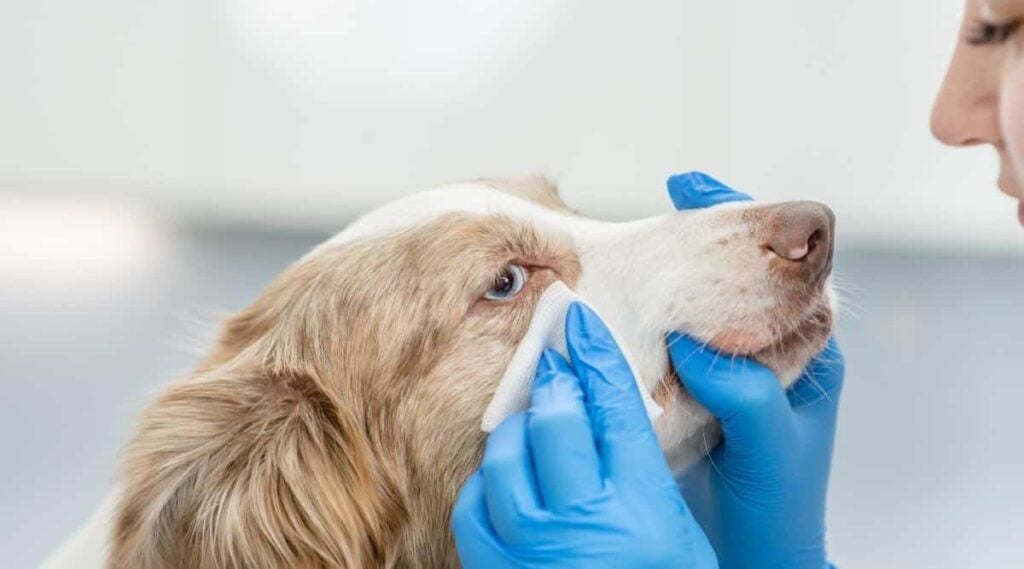
1. Keep Their Eyes Clean & Clear
Wipe your dog’s eyes gently with a clean, damp cloth if you notice any mild discharge, dust, or debris.
Regular cleaning helps prevent infections, especially in dogs prone to allergies, dry eyes, or conditions like cherry eye.
2. Avoid High-Risk Environments
Whenever possible, steer clear of dusty fields, smoky areas, or heavy pollen zones during allergy season.
If your dog loves sticking their head out of the car window, consider using a dog-safe eye shield to protect against wind and debris.
3. Schedule Regular Vet Checkups
Many serious eye issues like glaucoma, cataracts, and uveitis develop quietly at first. Annual exams can detect early warning signs before they develop into major problems. If your dog belongs to a breed that’s prone to eye conditions, like Cocker Spaniels, Bulldogs, or Pugs, ask your vet about more frequent eye exams.
4. Watch For Early Warning Signs
Stay alert for any redness, squinting, discharge, or behavior changes. The sooner you catch an eye problem, the easier and less expensive it usually is to treat.
5. Protect Their Eyes During Play & Outdoor Activities
Rough play, digging, and running through brushy trails are all opportunities for eye injuries. Supervise outdoor activities whenever possible, and inspect your dog’s face and eyes after each adventure.
6. Keep Their Face Groomed
For long-haired breeds, keeping hair trimmed around the eyes prevents irritation and reduces the risk of scratches or infections. Ask your groomer or vet for help if you’re unsure how much to trim safely.
Keeping your dog’s eyes healthy isn’t complicated. It’s about building small, smart habits into your routine. A few extra minutes of care now can help your dog avoid painful eye conditions and costly treatments later.
How To Clean Your Dog’s Eyes (Video)
Do your dog’s eyes often get goopy? Check out this video from a professional dog groomer for some tips on how to clean your dog’s eyes at home (and how to make it comfortable for your pup). Again, it is recommended to check with your vet before treating your dog’s eyes at home.
Next up, I answer some of the most common questions dog owners ask about red, bloodshot eyes, so you’ll feel even more confident knowing what’s normal and what’s not.
Frequently Asked Questions
Wondering if your dog’s red eyes are something you can handle at home or if it’s time for a vet visit?
You’re not alone. I’ve answered some of the most common questions dog owners have about red, bloodshot eyes below. Still have questions? Please share your concerns in the comments section; we’d love to hear from you and help you find the answers you need.
What If It’s Red Around My Dog’s Eyes?
If your dog’s eyelids are red and swollen, it could be a condition called blepharitis, which is an inflammation of the eyelids. Allergies, infections, congenital abnormalities, tumors, or inflammatory disorders can cause blepharitis. If your dog’s eyelids are red and swollen, it’s best to get him checked by your veterinarian.
What If There’s A Red Spot In My Dog’s Eye?
If you notice a small red spot in your dog’s eye, it could just be a minor broken blood vessel. This usually isn’t a cause for concern and should clear up on its own. However, it could also be a developing ulcer or early signs of a more serious condition, such as uveitis. Even if your dog seems comfortable, any visible changes inside the eye deserve prompt veterinary attention. Early treatment can prevent permanent damage and protect your dog’s vision.
Is There A Home Remedy To Treat Dog Red Eyes?
It’s wise to seek veterinary attention to determine the cause of your dog’s red eyes and to get the appropriate treatment. However, if you think it’s debris that’s gotten into your dog’s eye, you can use a dog eye wash like Burt’s Bees Eye Wash for Dogs, which is a saline solution, or Nutri-Vet Eye Rinse for Dogs, a boric acid solution. Both are safe for dogs, but it’s best to consult with your veterinarian beforehand to rule out any underlying issues.
How Can I Protect My Dog’s Eyes During Outdoor Activities?
Limit your dog’s exposure to dusty, windy, or smoky environments when possible. After hikes, trips to the beach, or car rides with the window down, check your dog’s eyes for debris. Consider protective dog goggles, often referred to as “doggles,” if your dog is highly active outdoors or prone to eye injuries. We have a dedicated guide on taking your dog camping and hiking, with safety tips and recommended products to keep your pup safe.
Explore More Ways To Keep Your Dog Healthy
Keeping your dog’s eyes healthy is just one piece of the puzzle. If you’re looking for ways to support your dog’s joints as they age, check out our guide to the best joint supplements for dogs. For a shinier coat and better overall health, you’ll want to learn about the benefits of fish oil supplements for dogs. A strong gut is key to a strong immune system, so don’t miss our recommendations for the best dog probiotics. And, of course, nutrition is the foundation of good health. Be sure to explore our expert tips on selecting the best dog food and nutrition plans to keep your pup thriving at every stage of life.
Has your dog ever struggled with red or irritated eyes? We’d love to hear your story, so please share your experience and any tips in the comments below!
Why Trust Canine Journal
Sally has over 20 years of experience in human health sciences communications, including 10 years specializing in pet health conditions and treatments such as red eyes, allergies, joint issues, and more. She’s part of a team of dedicated canine professionals and long-time dog owners at Canine Journal, where they research and test the best pet products and health solutions to help dogs live happier, healthier lives.
